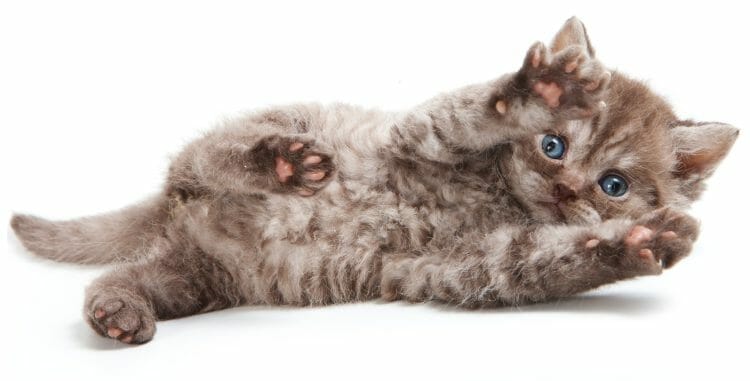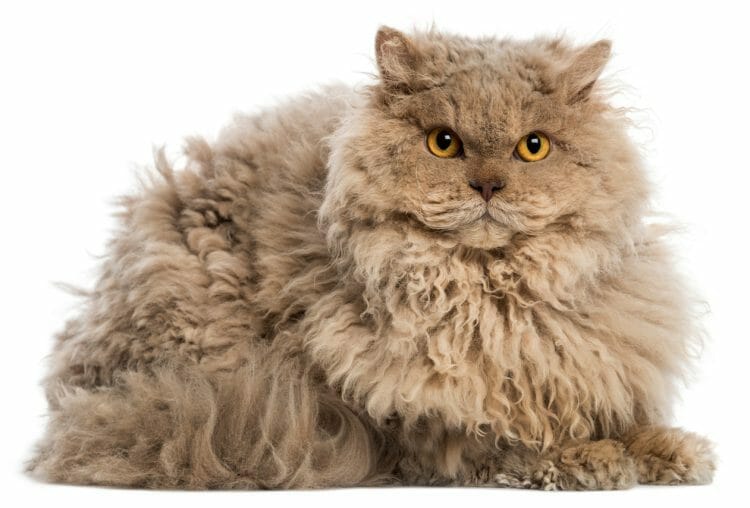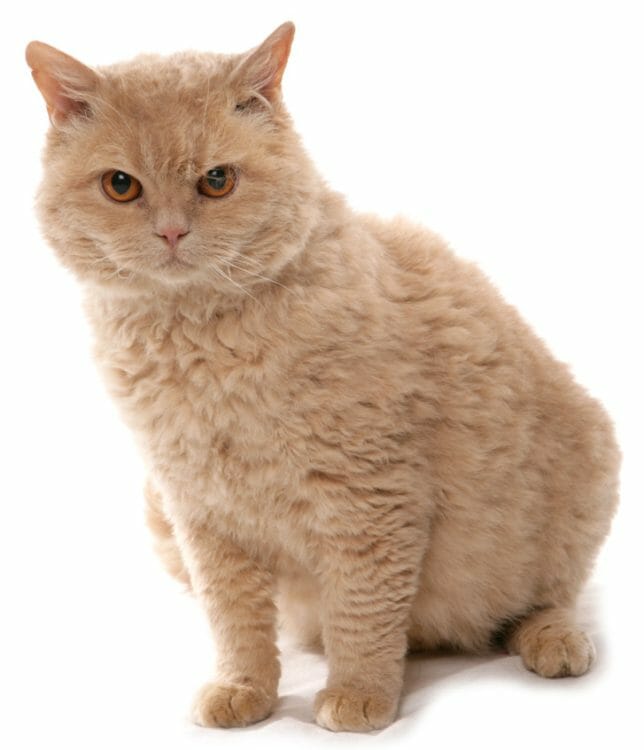Selkirk Rex

Selkirk Rex Breed Information
Although it shares its name with a town in Scotland, the Selkirk Rex cat hails from the U.S. state of Montana. The first Selkirk was born to a rescued cat in 1987. Named Miss DiPesto (after a character in the TV series Moonlighting), the curly-haired kitten was given to a Persian breeder called Jeri Newman. The breed was named after Newman’s stepfather, Selkirk. Currently, this makes it the only breed to take its name from a person.
Newman bred Miss DiPesto with a black Persian. Of the resulting litter, three were curly-haired Selkirk Rex kittens while the remaining three had straight hair. This indicated that Miss DiPesto’s signature appearance was caused by an autosomal dominant wooly rexoid hair gene. Other Rex breeds—such as the Devon and Cornish Rex—differ slightly, getting their characteristics from a recessive gene.
Breeding programs have used Persians, Exotic Shorthairs, British Shorthairs, American Shorthairs, and Himalayans. In most cases, the American Shorthair is no longer used in outcrossing. The practice of outcrossing this breed ceased completely in Australia in 2015.
Just five years after the breed was established, it was officially recognized by The International Cat Association. Recognition from the American Cat Fanciers Association followed in 1998 and from Cat Fanciers’ Association in 2000.

What Does a Selkirk Rex Cat Look Like?
Although the Selkirk Rex may have curly hair like the other two Rex breeds, its personality and build are completely different. With the influence of Persians, British Shorthairs, and Exotic Shorthairs in its development, the Selkirk has a rounder head, larger body, and rounder eyes.
Medium to large in stature and weighing up to 16 pounds, the Selkirk Rex comes in most patterns and colors, including pointed. Their coats can either be short or long.
Is the Selkirk Rex Hypoallergenic?
It is often reported that the Selkirk Rex is hypoallergenic due to the texture of its coat. Unfortunately, this is not the case. Allergies are caused by a protein called Fel d 1, which is transferred from the cat’s saliva to its skin during grooming. Thus, it is the dander and not the fur that causes allergic reactions. Although some breeds have a lower concentration of Fel d 1 in their saliva, the Selkirk Rex does not.

Selkirk Rex Personality
Notably more relaxed than other Rex breeds, the Selkirk takes much of its personality from its British Shorthair and Persian forefathers. Although fairly placid, these cats do enjoy playing. Owners often describe Selkirks as endearing, affectionate, and fun.
Although the Selkirk Rex enjoys the company of both people and animals, it is not a lap cat. Loneliness can be a problem for this breed, so avoid leaving it alone for long periods. If a Selkirk feels ignored, it will demand attention in a polite but assertive manner.

Selkirk Rex Grooming
The dense coat of the Selkirk needs to be combed weekly. This will help prevent knots and mats from forming and remove any dead hair. Bathing a Selkirk is not always necessary. However, if the cat becomes dirty, use a moisturizing shampoo to maintain a healthy coat and allow it to dry naturally in a warm area.
To prevent periodontal disease, brush the cat’s teeth at least weekly, if not daily. Discharge may accumulate around the corners of the eyes. When this happens, use a damp cloth to gently wipe it away. It is important to use a different part of the cloth on each eye to prevent the spread of any infection.
Each week, check the ears. If they appear dirty, use a cotton ball or a moist cloth to wipe them clean. Do not use cotton swabs as these may damage the ear.
Selkirks are meticulous about their litter box, so be sure it is always kept clean.

Selkirk Rex Health Issues
Because the Selkirk Rex is a relatively new breed, there is very little data regarding potential genetic health concerns. As Selkirk breeding programs used British Shorthairs, American Shorthairs, and Persians, it is possible to gain an understanding of potential health concerns by looking at these cats.
Due to the shortness of the skulls in these felines, there is an increased risk of dental problems, damage to the eyes, and breathing difficulties. Other possible health conditions to look for include hypertrophic cardiomyopathy, polycystic kidney disease, and hip dysplasia.
- Hypertrophic Cardiomyopathy (HCM) is a heart condition that affects many breeds, including the Selkirk Rex. Cats with HCM experience a thickening of their heart’s walls. This, in turn, makes it harder to pump oxygenated blood around the body. There is no cure for HCM. However, if diagnosed early, the right medication can be administered and life-threatening complications (such as heart failure) can be avoided.
- Polycystic Kidney Disease may also be a concern as it is for the Selkirk’s Persian ancestors. This congenital disease causes cysts to form in the kidney. Eventually, the cysts will grow so large that they cause renal failure. This condition is present at birth. However, a cat may not have symptoms until the kidneys are severely compromised. A genetic test can be carried out to determine whether a kitten has cysts, and an ultrasound will indicate the severity. The aim of treatment is to retain kidney functionality. Cats that have this condition should not be bred, and any animals used in breeding should be screened for genetic conditions like this one.
- Hip Dysplasia. There is an increased risk of hip dysplasia with this larger breed of cat. This hereditary condition occurs when the ball and joint socket of the cat’s hip are poorly formed. Cats with the condition will have problems walking and jumping and it can cause considerable pain and discomfort. A veterinarian will carry out an X-ray to confirm the diagnosis, and the dysplasia can be corrected surgically.

Selkirk Rex Lifespan
Typically, the Selkirk Rex will live between 10 and 15 years. Regular visits to a veterinarian will ensure no major health problem goes undetected. In addition, owners should provide recommended vaccines (such as those for distemper and rabies) and provide preventive medication for fleas, ticks, and heartworm.
Selkirk Rex Adoption
Before looking for a Selkirk Rex for sale, always consider adopting. Every year, countless cats are put up for adoption at rehoming centers. Always find a rescue shelter that operates a no-kill policy. Centers such as these will never euthanize a healthy cat.




